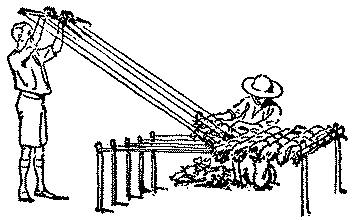 |
| Camp loom, for making mats and mattresses from the 1911 edition of the Boy Scout Handbook |
Through a circuitous bit of aimless interweb searching I came across a huge list of downloadable urban homesteading/gardening/survivalist manuals on a site called hardcorepreppers.com. Unfortunately, this site is so popular that it seems to be down every time I’ve checked. But thanks to Google’s caching feature I was able to access a list of those documents. Here’s a curated set of just a few of those links (through the letter “f”) that I found interesting. I can’t vouch for the reliability of any of this information but at least it’s entertaining. And if you have any other favorite free e-book sources please leave a link in the comments. At some point I’ll direct the Root Simple staff to add these and more to our resource page.
Food and Gardening
Bulk Sprouter
Bread Without an Oven
Building Soils for Better Crops
Colorado State University–Drying Vegetables
Collecting, Cutting and Handling Potato Seed
Everything Under The Sun: Food Storage for the Solar Oven
Medicine
Making Chinese Herbal Formulas Into Alcohol Extracts
The Ayurveda Encyclopedia Natural Secrets to Healing Prevention and Longevity
How to Make Cannabis Foods and Medicines
The Sacred Formulas of the Cherokees
Energy
Biogas
Biomass Stoves
Build your own Rocket Stove
Camp Stoves and Fireplaces
Transportation
Bicycle Know How
Zombie Apocalypse Skills (or “ZAS” since everything associated with the zombie apocalypse needs an acronym)
50 Emergency Uses for Your Camera Phone
Map Reading and Land Navigation
Boy Scouts Handbook 1911 Edition
Bug out Bag
5 Ways to Win a Fight
Guerilla Warfare by Che Guevara
Cold Weather Survival
Field Expedient Direction Finding



